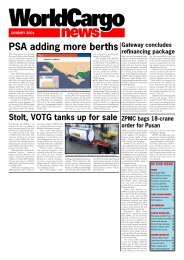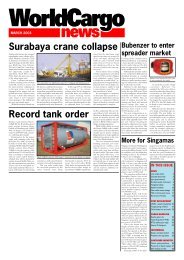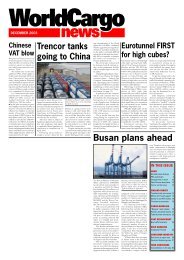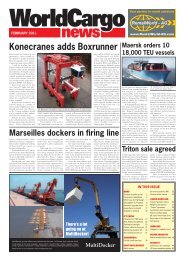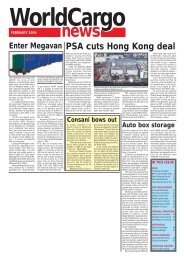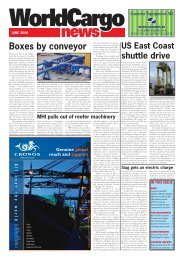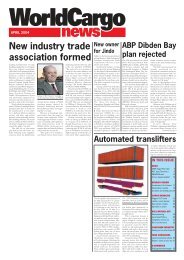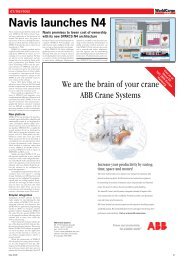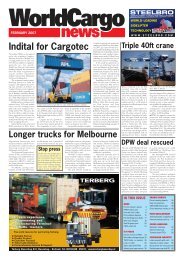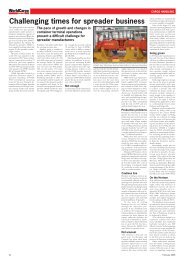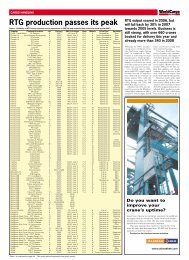Tanjung Priok super port - WorldCargo News Online
Tanjung Priok super port - WorldCargo News Online
Tanjung Priok super port - WorldCargo News Online
You also want an ePaper? Increase the reach of your titles
YUMPU automatically turns print PDFs into web optimized ePapers that Google loves.
NEWS ICT FOCUS<br />
Auckland’s efficiency drive<br />
Ports of Auckland is trying a new<br />
yard planning scheme as it gears<br />
up to transition to SPARCS N4<br />
New Zealand’s Ports of Auckland<br />
Limited (POAL) is charting<br />
a new course as it prepares to<br />
make the transition from Navis<br />
SPARCS to SPARCS N4. The<br />
move involves replacing several<br />
applications including SPARCS,<br />
the PACTS yard inventory system<br />
developed in Australia by<br />
Patrick Stevedores, and an inhouse<br />
development called PIMS<br />
(Port Information Management<br />
Systems) that provides billing<br />
functionality and operational re<strong>port</strong>ing<br />
with SPARCS N4.<br />
As previously re<strong>port</strong>ed, in<br />
2008 POAL contracted Korea’s<br />
Total Soft Bank to complete a<br />
“blueprint and detailed planning<br />
phase” for a comprehensive system<br />
covering all aspects of container<br />
terminal operations, CFS,<br />
billing and e-commerce services.<br />
After considering several options,<br />
Raoul Borley, POAL general<br />
manager of <strong>port</strong> operations, said<br />
the decision was made last year<br />
to stay with Navis, for several<br />
reasons.<br />
“We believe SPARCS N4<br />
is the best platform for an IT<br />
structure that can sup<strong>port</strong> our<br />
productivity targets and goal of<br />
being the technology leader in<br />
the New Zealand market,” he<br />
explained. POAL wants to embrace<br />
new technologies as they<br />
become available, and it believes<br />
Navis is a leader in this respect.<br />
“Navis has been tried and tested<br />
by most other large <strong>port</strong>s in<br />
New Zealand, POAL’s customers<br />
are familiar with it and POAL’s<br />
Board were assured that this was<br />
a good investment,” he added.<br />
Borley’s own experience with<br />
SPARCS N4 also played a role.<br />
He worked for 15 years in a variety<br />
of roles at Ports of Auckland<br />
prior to leaving in 2010.<br />
He then moved to UK-based<br />
Best Shore Business Solutions, a<br />
Navis SPARCS implementation<br />
partner and process improvement<br />
consultant, before returning to<br />
Auckland in January 2012.<br />
Productivity drive<br />
With a strong directive from the<br />
CEO and executive team, POAL<br />
has a clearly stated objective to<br />
raise its productivity, but it is not<br />
looking to SPARCS N4 to deliver<br />
a step change all by itself.<br />
POAL is engaged in process improvement<br />
right now, developing<br />
new yard planning and operational<br />
rules that it will carry over<br />
to SPARCS N4.<br />
Although it has made a lot of<br />
capital investment in STS cranes<br />
and straddle carriers, POAL in<br />
the past has struggled to achieve<br />
productivity over 28-29 moves<br />
per hour. Yard planning plays<br />
a key role in crane rates and<br />
this was one of the main areas<br />
where Borley saw immediate<br />
scope for improvement. “Though<br />
we use Navis Expert Decking,<br />
we weren’t using it very well,”<br />
he said.<br />
Before testing any new strategies<br />
an expert was brought in<br />
to conduct a detailed analysis of<br />
cargo types and container distribution<br />
across the yard. This analysis<br />
showed how better planning<br />
of container locations could sup<strong>port</strong><br />
higher vessel productivity.<br />
Since then the <strong>port</strong> has<br />
changed yard allocation criteria<br />
to better utilise the stacking area<br />
closer to the quayside. The focus<br />
of yard planning has gone from<br />
minimising straddle travel distances<br />
to staging and re-planning<br />
the yard to sup<strong>port</strong> higher crane<br />
productivity. This does mean<br />
straddle carriers are doing more<br />
moves, but they are performed<br />
within existing shifts, so the additional<br />
cost is limited to fuel and<br />
maintenance.<br />
Some of the planning concepts<br />
POAL is implementing are<br />
in fact borrowed from ASC yard<br />
planning, where containers are<br />
commonly moved three or more<br />
times as they progress from the<br />
landside to the waterside end of<br />
the block. Other new ideas are<br />
being developed in conjunction<br />
with Navis.<br />
Dwell time<br />
POAL is also tackling shipping<br />
practices that adversely affect its<br />
productivity. Dwell times are 2.5<br />
days for im<strong>port</strong> containers and<br />
3.5 for ex<strong>port</strong> boxes, but these<br />
figures do not include rolled<br />
boxes. It has made significant<br />
progress tackling the problem of<br />
containers arriving at the terminal<br />
without a Customs Ex<strong>port</strong><br />
Delivery Order (CEDO). Shippers<br />
would apply for a CEDO<br />
when the box was in the yard,<br />
but if it was not given, the container<br />
would have to be removed<br />
from the loading list and rolled.<br />
This played havoc with yard<br />
and vessel planning and POAL<br />
worked out 53% of vessels were<br />
impacted by CEDO issues. It<br />
was particularly a problem where<br />
one box in a pre-staged twin-lift<br />
pair failed to obtain a CEDO.<br />
Since February POAL has been<br />
enforcing a policy of removing<br />
from the load list any box without<br />
a CEDO two hours prior<br />
to the vessel ETA, and charging<br />
demurrage if the box is subsequently<br />
rolled. Financial penalties<br />
are bringing a change in shipper<br />
behaviour.<br />
Through a combination of<br />
process and yard planning<br />
changes POAL has been able to<br />
lift crane productivity above 32<br />
moves per hour. Borley said it<br />
recently hit 37 moves on several<br />
vessels and he is confident the<br />
terminal can get to 42 without<br />
adding more handling equipment.<br />
The experience has highlighted<br />
to POAL the difference<br />
between just using a TOS and<br />
using more advanced features to<br />
the full extent to unlock the potential<br />
of its investment in equipment.<br />
It has decided to purchase<br />
TBA’s CONTROLS emulation<br />
software to give it the ability to<br />
test different scenarios and configurations<br />
as it continues this<br />
process.<br />
Path to SPARCS N4<br />
Borley acknowledges that transitioning<br />
to SPARCS N4 is a<br />
big challenge, particularly in the<br />
integration and EDI areas where<br />
other <strong>port</strong>s are still having issues.<br />
POAL will manage as much of<br />
the transition as possible itself,<br />
and is now developing a plan<br />
for testing interfaces and implementing<br />
the software in stages.<br />
At this stage the plan is to<br />
make the transition in the Q2<br />
2014. Concurrently, POAL is<br />
running a separate tender for a<br />
Gate Operating System, which<br />
will be rolled out with gate and<br />
crane OCR after the TOS implementation<br />
is complete. Another<br />
project undergoing evaluation<br />
is a new GPS system for the<br />
straddle carriers that will be used<br />
to sup<strong>port</strong> real time container in-<br />
Auckland is using yard gantry crane planning concepts to sup<strong>port</strong> higher crane<br />
productivity with a straddle carrier system<br />
ventory and yard planning.<br />
Borley emphasised that getting<br />
the most out of SPARCS<br />
N4 entails a lot more challenges<br />
than the technical, integration<br />
aspects. POAL wants to work<br />
with its customers to show them<br />
how current business practices<br />
impact <strong>port</strong> productivity, and in<br />
some cases get them to embrace<br />
change. The <strong>port</strong> could mandate<br />
RFID truck tagging, for example,<br />
but a lot more efficiencies<br />
could be gained if the trucking<br />
community embraced RFID in<br />
its planning too. The <strong>port</strong> is now<br />
engaging with the wider New<br />
Zealand supply chain, including<br />
other NZ <strong>port</strong>s, on addressing<br />
some of these issues. <br />
Maher starts roll out<br />
Maher Terminals in New Jersey<br />
is now rolling out SPARCS<br />
N4, which would bring to an<br />
end what is believed to be the<br />
longest running SPARCS N4<br />
implementation project to<br />
date.<br />
Maher made the announcement<br />
that it would replace its<br />
in-house TOS with SPARCS<br />
N4 in 2008 and has been<br />
conducting extensive on-site<br />
testing using Aecom’s General<br />
Marine Terminal Emulation<br />
tool.<br />
This couples a simulation engine<br />
to the TOS to test how the<br />
TOS functions with real operational<br />
data and gives a graphical<br />
overview of how a terminal<br />
operates under the rules and<br />
parameters of the TOS planning<br />
functionality.<br />
The cultural and operational<br />
transition from Maher’s inhouse<br />
system to SPARCS N4<br />
has been a significant factor in<br />
prolonging the project.<br />
After it acquired Maher<br />
Terminals, Deutsche Bank’s<br />
RREEF Infrastructure reviewed<br />
its business and Brad<br />
Gordon, director of acquisitions,<br />
said Maher’s processes<br />
were out of step with the rest<br />
of the industry. He described<br />
its in-house TOS as a “huge<br />
waste of money” with “all the<br />
learnings of Maher and none<br />
of the learnings of the rest of<br />
the industry.”<br />
Maher is taking the final implementation<br />
in stages, starting<br />
with the empty depot in April<br />
before moving on to its main<br />
container terminal this month.<br />
Aspects of its existing<br />
CTMS TOS will run in parallel<br />
with SPARCS N4 for a<br />
time before the transition is<br />
completed in June.<br />
This makes the implementation<br />
period more complicated,<br />
with customers required to<br />
enter data into two systems at<br />
times, but significantly lowers<br />
the risk of operational problems.<br />
May 2013 35



